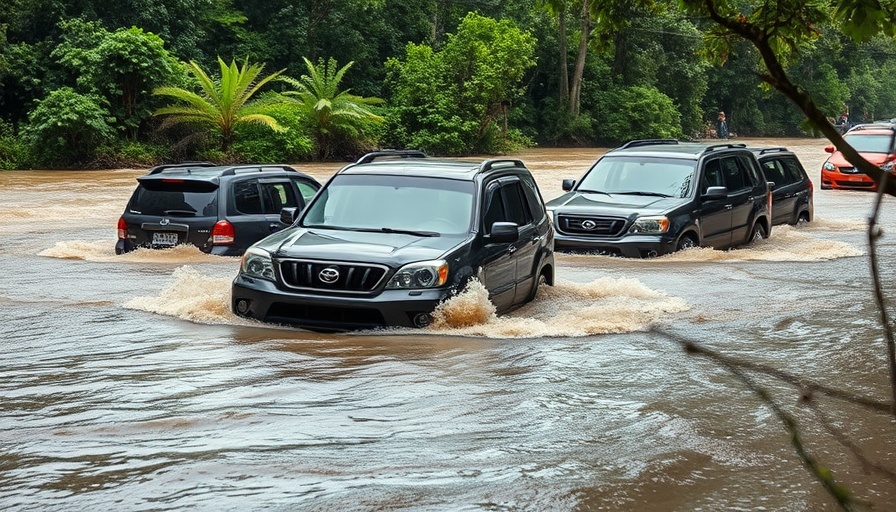
Understanding Flash Floods: A Hidden Danger
Flash floods are often perceived as rare occurrences, yet they are responsible for more fatalities than any other storm-related incident, with many deaths being preventable. When heavy rainfall occurs, particularly over a brief span, it leads to an overwhelming surge of water that can swiftly become deadly. Imagine enjoying a sunny day by a river, only to be caught off-guard by a torrent of water racing toward you—this is the harsh reality of flash floods.
How Much Water Does it Take?
According to the National Weather Service (NWS), even mild flooding can be deadly. Just six inches of fast-moving water can easily knock over an adult, while twelve inches can sweep away most vehicles. This stark reality highlights the unpredictable nature of flash floods. In areas like deserts, where the ground is baked and dry, even an inch of rain can create a sudden rush of water. Understanding that a seemingly innocuous rain can pose a significant threat is crucial for everyone.
Causes Behind Flash Floods
Several factors contribute to the onset of flash floods. The terrain plays a pivotal role; cities with extensive concrete surfaces often face more severe flooding outcomes, as there is less vegetative space to absorb the water. Additionally, previous rainfall can leave the ground saturated, increasing the likelihood of swift runoff during subsequent storms. Flash floods can also result from upstream rainfall, even if your local area is dry. Therefore, awareness and preparation are vital, especially during outdoor activities like hiking.
Safety Tips: Turn Around, Don’t Drown
The National Weather Service effectively summarizes safety with the mantra "Turn Around, Don’t Drown." It’s essential to heed flood warnings and respect barricades designed to prevent access to flooded areas. If faced with the choice of crossing flooded paths, it’s crucial to remember that just inches of water can carry you away. Carrying a weather radio while exploring can be a life-saving measure, keeping you informed of sudden changes in weather conditions.
The Emotional and Human Element of Flash Floods
The impact of flash floods isn't solely physical; it also has significant emotional repercussions. Survivors and families of victims are often left dealing with profound grief and trauma. Experts like David T. Williams recount heartbreaking stories, such as those related to a tragic accident involving a driver and a child that could have been avoided had proper caution been exercised. These narratives remind us of the human toll of flooding incidents and underline the necessity for community education.
Flash Flood Warnings and Their Importance
The NWS issues alerts to inform communities of impending danger during flood-prone weather. Understanding these warnings is crucial for personal safety. A flash flood watch means that conditions are favorable, while a flash flood warning indicates that flooding is imminent—time to act is of the essence. Staying informed can mean the difference between safety and disaster.
Connected Living: The Insurance Perspective
As homeowners and renters, understanding the risks associated with flash floods has significant implications for our living situations. Investing in proper insurance coverage is essential in flood-prone areas. This proactive approach not only safeguards personal property from potential damage but also assures peace of mind during stormy seasons.
Taking Action: Community Preparedness
Communities can collectively mitigate the impacts of flash floods by promoting awareness and encouraging preparedness. Programs that educate local residents about safe practices, flood responses, and emergency contacts are vital to a community's resilience. Local governments can also invest in better infrastructure to handle heavy rainfall and encourage green spaces that can absorb excess water.
It's essential to stay informed about weather patterns, flood risks, and preparation strategies. Remember, a few inches of water might not seem threatening initially, but it can lead to devastating consequences. Taking steps today can prepare us for safer tomorrows.
Take Action: Stay Informed and Prepared! As we face more unpredictable weather patterns, it’s crucial to prioritize safety and stay knowledgeable about flash floods. Join local community preparedness programs, follow weather alerts, and most importantly, spread awareness on how to act during a flash flood. Your proactive steps can save lives.
 Add Row
Add Row  Add
Add 




Write A Comment